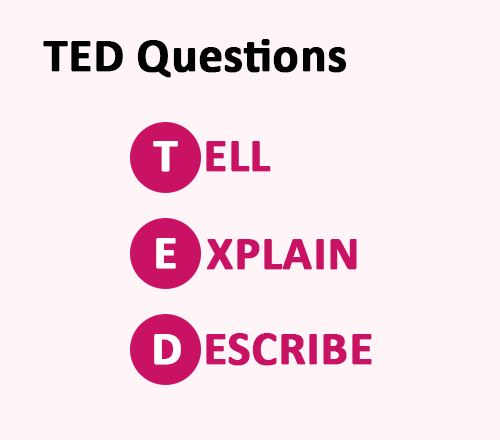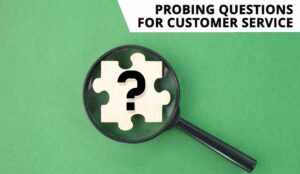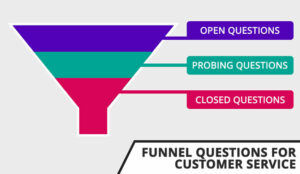Want to know how can you better weave probing questions into your customer conversations? Here are five questioning techniques that can help:
Use the “Know, Feel, Do” Approach

It is so easy to take the ‘we’ve got something to say’ approach, but we instead should think about what the customer needs to know.
“Consider how the customer feels and how we want them to feel. If we can manage that, we have a real handle on how to help someone. This bit too often gets missed when we become obsessed with information,” says Neil.
So, think about probing questions in two ways:
- Gaining the information to move the conversation along – The Know
- Gaining the insights to meet the customer’s emotional needs – The Feel
The Do part involves the action that you take once you have used probing questions to unlock the know and the feel, as you then have all the information you need to move forwards.
As Neil says: “If there is an action that either we or the customer needs to take, just make that really clear. After all, we all really like simple, easy steps.”
Follow Up Probing Questions With a Closed Question
One way to think of probing questions is as the second phase of three when getting to grips with a customer’s problem.
Stage 1 – Ask Open Questions:
The first step in any contact is to ask open questions regarding the matter at hand, so you can listen out for key bits of information, which you can then probe into to find a solution…
Step 2 – Ask Probing Questions:
Once you are aware of the key issue at hand, probing questions are used to gather more information, as well as the emotion behind that, which will lead you to move forward with the contact.
Step 3 – Ask Closed Questions:
As your probing questions begin to bear fruit, confirm your suspicions as to what the issue may be by asking simple “yes” or “no” questions. These will help to confirm both your, as the advisor, and the customer’s understanding of the issue.
This three-step approach to contact handing is also known as “The Funnel Effect” and it can provide a nice guide for advisors to use.
But it is best not to use this rigidly, as it isn’t always best practice to immediately follow up one step with the next. Maybe it is better to ask multiple probing questions before following up with a closed question, for example.
Consider the TED Approach
TED stands for Tell, Explain and Describe. These are used to introduce a probing question, so the customer focuses on giving us the most relevant information to answer their query.
For example, here’s how we can frame three of the probing question examples above by using the TED approach:
- Tell me, what impact has this had on your…?
- Explain to me what difficulties did you run into when you tried to…?
- Describe to me how it looks/sounds?

By adding these simple words to your probing questions, you can nudge customers into giving you specific details of the issue, without coming across as overly demanding.
“This technique can be really good when the customer is struggling to explain something really complicated, as we can approach the query from a number of different angles. Just be careful that your use of TED questions doesn’t become repetitive,” adds Neil.
For more information on the TED questioning technique, read our article: 15 TED Questions for Customer Service – With Examples
Try to Avoid Asking the “Why?”
As you may have noticed, none of our recommended probing questions begins with the word “why”. This is because we don’t want to accuse customers of being to blame for the problem. That’s not good customer service.
If the customer did something wrong, they likely did it because we didn’t set clear expectations of how to use our product/solution. That will be their interpretation at least.
Yet it can be difficult to avoid the word “why”. If you find this the case, try reframing the question with an opening like “Just so I have the full details…”
By reframing the question in this way, we can take away the potential feeling that you are accusing the customer of being in the wrong.
Use Empathy Statements to Complement Probing Questions
When you empathize with people, they often switch from telling you the facts to telling you how they feel, as Neil Martin tells us.
“Sometimes customers are ready for an argument and armed with the details of what happened – but really what they want to say is ‘This has really upset me!’” says Neil.
“So, while using empathy statements is not technically asking a question, it has the effect of a probing question, because it helps people to open up and move away from the factual side of why they are contacting you.”
If we also add an inflexion to the end of our empathy statements, as we naturally would when asking a question, the customer can be encouraged to express themselves and we can probe deeper into their response.
Here are three examples of how to use empathy phrases as probing statements:
- I’m sure that I would feel the same in your situation…
- I can tell that this has been really difficult for you…
- I’m really sorry to hear that…
For a list of useful empathy statements, read our article: Empathy Statements for Customer Service – with AER Statement Examples
Soft Skills That Can Also Help You Deliver Probing Questions
While you can use probing techniques to improve your questioning, what matters most is the soft skills that lie behind that.
Here are three of the most important advisor soft skills that will positively influence their ability to use probing questions:
Active Listening
We need to find out the customer’s primary reasons for calling in order to ask the most relevant probing questions.
But sometimes this can be very difficult, as some may bombard us with information. So, to do this, we need to listen carefully not only to what is being said, but also to the vocabulary and the tone that the customer is using.
Empathy
We want to probe into how the customer is feeling – not just for information to solve their query.
Showing empathy is central to this, and we can do this through the tone of our probing questions, as well as by using empathy statements.
Patience
We can’t jump in with a solution before the customer has had the chance to express everything that they want to. This can lead to resentment.
Instead, we need to be patient and listen out for those golden nuggets of information in the conversation, so we build rapport and offer the best possible solution that’s tailored to the customer’s functional and emotional needs.
For more necessary skills for contact centre advisors, read our article: The Top 10 Most Important Customer Service Skills
Want More Advice on Having Better Conversations?
For more advice on coaching advisors to have better conversations with customers, read our articles:
- Positive Customer Service Language for Positive Conversations
- 15 Example Probing Questions to Better Understand Your Customers
- Customer Psychology: The Key to Better Contact Centre Conversations
- Replace Negative Words With Positive Alternatives for Customer Service
Author: Megan Jones
Reviewed by: Robyn Coppell
Published On: 19th Apr 2024 - Last modified: 19th Sep 2025
Read more about - Call Centre Management, Customer Service, Language, Management Strategies, Positive Words, Questioning Techniques









































